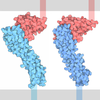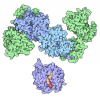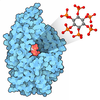[English] 日本語
 Yorodumi
Yorodumi- PDB-1jeg: Solution structure of the SH3 domain from C-terminal Src Kinase c... -
+ Open data
Open data
- Basic information
Basic information
| Entry | Database: PDB / ID: 1jeg | ||||||
|---|---|---|---|---|---|---|---|
| Title | Solution structure of the SH3 domain from C-terminal Src Kinase complexed with a peptide from the tyrosine phosphatase PEP | ||||||
 Components Components |
| ||||||
 Keywords Keywords | TRANSFERASE/HYDROLASE / SH3 domain / protein-peptide complex / tyrosine phosphatase / kinase / TRANSFERASE-HYDROLASE COMPLEX | ||||||
| Function / homology |  Function and homology information Function and homology informationpositive regulation of granzyme B production / phosphoanandamide dephosphorylation / negative regulation of Golgi to plasma membrane protein transport / RHOH GTPase cycle / GAB1 signalosome / Phosphorylation of CD3 and TCR zeta chains / Translocation of ZAP-70 to Immunological synapse / Negative regulation of FLT3 / regulation of Fc receptor mediated stimulatory signaling pathway / negative regulation of nucleotide-binding oligomerization domain containing 2 signaling pathway ...positive regulation of granzyme B production / phosphoanandamide dephosphorylation / negative regulation of Golgi to plasma membrane protein transport / RHOH GTPase cycle / GAB1 signalosome / Phosphorylation of CD3 and TCR zeta chains / Translocation of ZAP-70 to Immunological synapse / Negative regulation of FLT3 / regulation of Fc receptor mediated stimulatory signaling pathway / negative regulation of nucleotide-binding oligomerization domain containing 2 signaling pathway / Co-inhibition by PD-1 / regulation of natural killer cell proliferation / positive regulation of toll-like receptor 3 signaling pathway / regulation of leukocyte migration / positive regulation of toll-like receptor 7 signaling pathway / Integrin signaling / positive regulation of toll-like receptor 9 signaling pathway / MAP2K and MAPK activation / regulation of non-canonical NF-kappaB signal transduction / negative regulation of p38MAPK cascade / positive regulation of toll-like receptor 4 signaling pathway / positive regulation of protein K63-linked ubiquitination / cellular response to muramyl dipeptide / negative regulation of T cell activation / negative regulation of interleukin-8 production / adherens junction organization / proline-rich region binding / negative regulation of low-density lipoprotein particle clearance / negative regulation of bone resorption / cellular response to peptide hormone stimulus / negative regulation of phagocytosis / positive regulation of CD8-positive, alpha-beta T cell proliferation / negative regulation of T cell receptor signaling pathway / positive regulation of NLRP3 inflammasome complex assembly / protein kinase A catalytic subunit binding / non-membrane spanning protein tyrosine phosphatase activity / negative regulation of interleukin-6 production / oligodendrocyte differentiation / positive regulation of interferon-alpha production / T cell differentiation / negative regulation of tumor necrosis factor production / protein dephosphorylation / positive regulation of defense response to virus by host / protein-tyrosine-phosphatase / protein tyrosine phosphatase activity / positive regulation of interferon-beta production / protein tyrosine kinase binding / non-membrane spanning protein tyrosine kinase activity / non-specific protein-tyrosine kinase / negative regulation of ERK1 and ERK2 cascade / SH3 domain binding / positive regulation of protein import into nucleus / lipid metabolic process / autophagy / kinase binding / cytoplasmic side of plasma membrane / cell-cell junction / T cell receptor signaling pathway / transferase activity / protein tyrosine kinase activity / protein phosphatase binding / adaptive immune response / positive regulation of ERK1 and ERK2 cascade / intracellular signal transduction / negative regulation of cell population proliferation / negative regulation of gene expression / positive regulation of gene expression / perinuclear region of cytoplasm / ATP binding / metal ion binding / identical protein binding / nucleus / plasma membrane / cytoplasm Similarity search - Function | ||||||
| Biological species |  | ||||||
| Method | SOLUTION NMR / simulated annealing, torsional angle dynmaics | ||||||
 Authors Authors | Ghose, R. / Shekhtman, A. / Goger, M.J. / Ji, H. / Cowburn, D. | ||||||
 Citation Citation |  Journal: Nat.Struct.Biol. / Year: 2001 Journal: Nat.Struct.Biol. / Year: 2001Title: A novel, specific interaction involving the Csk SH3 domain and its natural ligand. Authors: Ghose, R. / Shekhtman, A. / Goger, M.J. / Ji, H. / Cowburn, D. | ||||||
| History |
|
- Structure visualization
Structure visualization
| Structure viewer | Molecule:  Molmil Molmil Jmol/JSmol Jmol/JSmol |
|---|
- Downloads & links
Downloads & links
- Download
Download
| PDBx/mmCIF format |  1jeg.cif.gz 1jeg.cif.gz | 588 KB | Display |  PDBx/mmCIF format PDBx/mmCIF format |
|---|---|---|---|---|
| PDB format |  pdb1jeg.ent.gz pdb1jeg.ent.gz | 491.1 KB | Display |  PDB format PDB format |
| PDBx/mmJSON format |  1jeg.json.gz 1jeg.json.gz | Tree view |  PDBx/mmJSON format PDBx/mmJSON format | |
| Others |  Other downloads Other downloads |
-Validation report
| Summary document |  1jeg_validation.pdf.gz 1jeg_validation.pdf.gz | 354.8 KB | Display |  wwPDB validaton report wwPDB validaton report |
|---|---|---|---|---|
| Full document |  1jeg_full_validation.pdf.gz 1jeg_full_validation.pdf.gz | 727.7 KB | Display | |
| Data in XML |  1jeg_validation.xml.gz 1jeg_validation.xml.gz | 43.8 KB | Display | |
| Data in CIF |  1jeg_validation.cif.gz 1jeg_validation.cif.gz | 67.2 KB | Display | |
| Arichive directory |  https://data.pdbj.org/pub/pdb/validation_reports/je/1jeg https://data.pdbj.org/pub/pdb/validation_reports/je/1jeg ftp://data.pdbj.org/pub/pdb/validation_reports/je/1jeg ftp://data.pdbj.org/pub/pdb/validation_reports/je/1jeg | HTTPS FTP |
-Related structure data
| Similar structure data |
|---|
- Links
Links
- Assembly
Assembly
| Deposited unit | 
| |||||||||
|---|---|---|---|---|---|---|---|---|---|---|
| 1 |
| |||||||||
| NMR ensembles |
|
- Components
Components
| #1: Protein | Mass: 9198.627 Da / Num. of mol.: 1 / Fragment: SH3 domain Source method: isolated from a genetically manipulated source Source: (gene. exp.)   |
|---|---|
| #2: Protein/peptide | Mass: 2912.187 Da / Num. of mol.: 1 / Fragment: 25 residue peptide (residues 612-629) Source method: isolated from a genetically manipulated source Source: (gene. exp.)   |
-Experimental details
-Experiment
| Experiment | Method: SOLUTION NMR |
|---|
- Sample preparation
Sample preparation
| Sample conditions | pH: 7.2 / Pressure: 1 atm / Temperature: 293 K |
|---|---|
| Crystal grow | *PLUS Method: other / Details: NMR |
-NMR measurement
| Radiation | Protocol: SINGLE WAVELENGTH / Monochromatic (M) / Laue (L): M | |||||||||||||||
|---|---|---|---|---|---|---|---|---|---|---|---|---|---|---|---|---|
| Radiation wavelength | Relative weight: 1 | |||||||||||||||
| NMR spectrometer |
|
- Processing
Processing
| NMR software |
| ||||||||||||
|---|---|---|---|---|---|---|---|---|---|---|---|---|---|
| Refinement | Method: simulated annealing, torsional angle dynmaics / Software ordinal: 1 | ||||||||||||
| NMR ensemble | Conformer selection criteria: structures with the lowest energy Conformers calculated total number: 1000 / Conformers submitted total number: 25 |
 Movie
Movie Controller
Controller






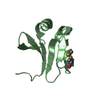
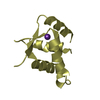




 PDBj
PDBj

